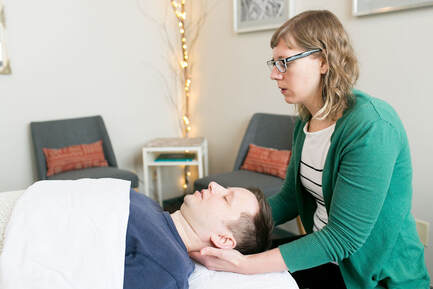|
In the midst of the pandemic, I have been taking some private lessons to learn more about Craniosacral Therapy (CST). I was drawn to this modality because it is very gentle and can be helpful for creating shifts in chronically tight areas of the body around the head, spine and sacrum. I've been integrating CST techniques into sessions with clients who are experiencing headaches, neck/shoulder tension, digestive concerns and low back/hip pain. The feedback has been very positive! Clients seem to find these techniques as an invitation for deep rest and have experienced less pain/tension after the session. I'd love to explore these techniques with you in your next massage, shiatsu or Chi Nei Tsang (abdominal massage) session, if you are interested. Craniosacral Therapy is now also being offered as a stand alone appointment type where we can spend a full 60 minutes working in this gentle and profound way. What is Craniosacral Therapy (CST)? Craniosacral therapy is a gentle bodywork therapy that focuses on releasing restrictions in the soft tissue around the central nervous system. The techniques center around the head, spine, sacrum and the cerebrospinal fluid that surrounds these structures. By tuning into the craniosacral rhythm, the therapist can assess where restrictions may be occurring and use gentle manipulation to ease restrictions and allow for an optimum craniosacral rhythm which supports overall vitality. Craniosacral Therapy can address many complex nervous system dysfunctions including concussions, traumatic brain injuries, scoliosis, PTSD, etc. As a new therapist to this modality, I feel comfortable addressing these complaints/disorders:
What is a CST session like? During a Craniosacral Therapy session, you will be laying face up on the massage table fully clothed. I will first assess your craniosacral rhythm by lightly placing my hands on certain areas of the body to “listen” to the rhythm. This gives me an idea of the quality of your rhythm as well as where any restrictions in the soft tissue might be. I will then use gentle techniques on the head, sacrum, or along the spine to release areas of restriction as well as increase movement and ease of flow of the cerebrospinal fluid. The amount of pressure is usually no more than the weight of a nickel. You may feel physical or energetic shifts as we work. You may also experience an increased sense of wellbeing and vitality. Many of my clients have stated that they feel a deep sense of calm, relaxation and balance after CST sessions. ***I recommend scheduling a 60 minute session if you would like to do a full CST session. Techniques can also be incorporated into a longer session 75 + minute massage, shiatsu or Chi Nei Tsang (abdominal massage) session if you are interested in getting a taste of what CST feels like and how it can help you with your session goals. Photo credit: Emma Freeman
1 Comment
4/10/2023 11:09:43 am
I liked it the most when you shared that craniosacral therapy session is able to address headaches and migraines. My friend has been complaining about headaches. I think it's best for her to opt for craniosacral therapy to relieve her headaches.
Reply
Leave a Reply. |
AuthorAmy Daws is a trained Therapeutic Massage, Shiatsu, Chi Nei Tsang and Craniosacral therapist. She is a nerd at heart and loves sharing what she is learning about with her clients. Archives
May 2024
Categories
All
|

 RSS Feed
RSS Feed